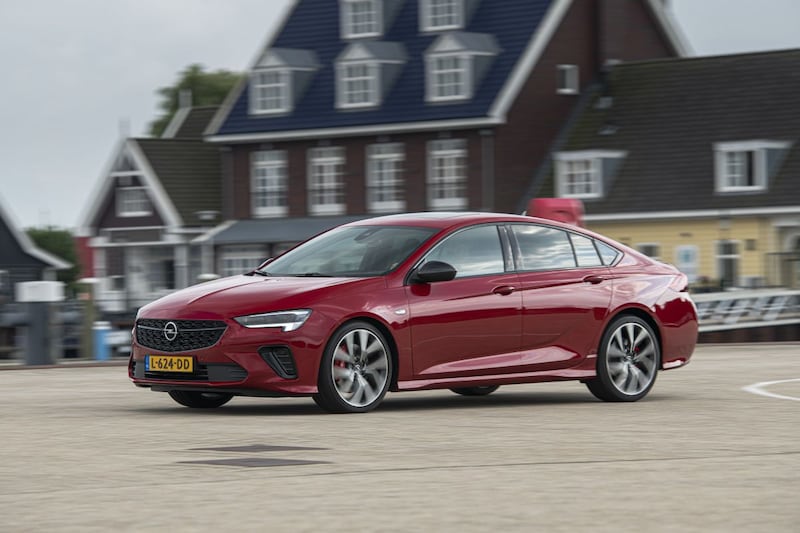The sporty D-segmenter seems to be a dying species. Still, there is hope: with a less CO2 emitting engine, the Opel Insignia GSi is back. Where is that last GM-Opel? To find out, we put this middle class Stellantis without PSA genes to a test.
Good news for fans of thick Opels: the Insignia GSi is back. That is quite remarkable to say the least at a time when large middle class cars seem to be an endangered species and sporty variants of them a rarity. From the beginning of 2018, the Insignia GSi was available with a choice of a potent petrol or diesel engine. Shortly after its introduction, however, the 260 hp petrol engine disappeared from the price list. His CO2 emissions made him virtually unsaleable under the WLTP regulations introduced in July 2018. The diesel lasted longer, but eventually disappeared silently through the back door.
End of Insignia GSi … Or not? With the latest update of the Insignia, not only was the design of the car updated, the drive technology was also revised. So it may happen that you can buy a GSi variant of the Insignia again. This fresh GSi is only available on petrol and with slightly less power than before. The engine now peaks at 230 hp, but that should not spoil the fun. Although Opel has since been acquired by PSA, which in turn has been absorbed into Stellantis, the new GSi engine still has a GM base, just like the Insignia itself. It is not worthwhile to adapt the car in the autumn of its career for a power source from the Stellantis shelves.
Corrective tap
At its return, the Insignia GSi had to give up 30 hp, which means it has only 30 hp more than the normal Insignia 2.0 Turbo. Just like the GSi, the latter also has a nine-speed automatic transmission, has to admit only a few tenths on the sprint from zero to 100 km/h on the GSi and is less than twenty mille cheaper than the GSi. Is there still a reason to prefer the GSi? Yes, it’s mainly the way the performance is brought to the tarmac. For example, unlike the regular 2.0 Turbo, the GSi has larger wheels, a modified chassis with electronically controlled variable damping and four-wheel drive instead of just front-wheel drive. That four-wheel drive does not use the familiar differential between the rear wheels. No, the drive forces are optimally distributed over the respective drive shafts via two couplings, even providing a torque vectoring effect in bends. We also know this piece of refined technology from, for example, the Ford Focus RS. Because the Insignia GSi can lose its powers via four wheels, a traffic light sprint is very nicely controlled. Opel’s new nine-speed automatic transmission is quite fast. Intervention in the gear selection process is seldom necessary and if this is the case, you have paddle shifters behind the wheel.
Remarkably neutral
Basically, the Insignia was conceived to serve the largest possible middle group, after which sharp edges were polished afterwards to make it a GSi. First of all, this results in a surprisingly good chassis. The operation of the electronically adjustable shock absorbers hardly seems to make any difference when you select the Sport mode. No disaster, the base is strong enough – without making it uncomfortable on long distances. The all-wheel drive with torque vectoring effect contributes to a remarkably neutral cornering behaviour. Thanks in part to the good grip of the Michelin Pilot Sport tires, you can accelerate the car out of a bend without a direct tendency to understeer. The Insignia responds nice and precise to the steering wheel. In normal driving mode, that’s fine for everyday use. In Sport mode you feel more resistance, although you do not get too much extra feedback in that sportier setting for a car with pretensions. In any case, you will not become a passenger in your own car. The boundaries are significantly further than what you can get away with with the applicable traffic rules on public roads.
Nice and complete
In the Insignia interior, black and gray dominate and the whole leaves a solid impression. You notice from the information provision that the model has been around for a while. For example, the Insignia does not yet have a fully digital instrumentation. And why too? Opel still has the necessary physical hands. However, the speedometer is digital and can be projected in various ways, just like an almost infinite series of data. You can make it as (un)organized as you want. The multimedia system is not ahead of the pack and that is actually a plus within the Stellantis group. You can still control a lot with physical keys and buttons.
This red Insignia is equipped with seats that offer a lot of support in all directions and of which (as an option) the sidewalls can be adjusted electrically if desired for extra lateral support at times when you are exploring the boundaries between driving and sliding. In the car you have enough space in the front in all directions, as it should be in generous D-segmenters. The Insignia offers rear passengers a fair amount of legroom. Opel’s hatchback is also practical thanks to its large tailgate, but also because the backrest of the rear seat can be folded down. As mentioned, the Insignia GSi gets active shock absorbers as standard, but also paddle shifters and a differential lock. Even when it comes to safety features, you will not be short of anything in the GSi, although Opel offers a number of safety items only for an additional fee. What the Insignia does have as standard is a short braking distance. Prevention is better than cure.
– Thanks for information from Autoweek.nl
